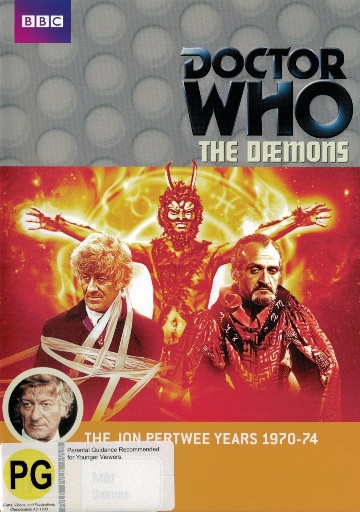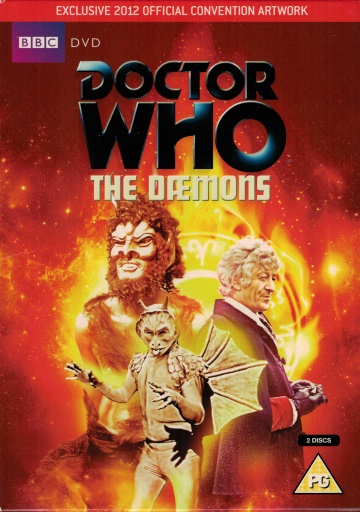C08S05 The Dæmons
Synopsis
In the peaceful village of Devil's End something very strange is happening. A professor is preparing to open a nearby burial mound and a local white witch foresees death and disaster. Meanwhile, the new vicar looks suspiciously like the Master and he is using black magic to conjure up an ancient Dæmon. Can the Doctor, Jo and UNIT stop their old enemy before he succeeds?
Cover notes
The Dæmons is a perfect example of a Doctor Who story in the early 1970s. Without the TARDIS, and with the restrictions of a Doctor exiled on Earth, it proves that the series can work equally well without alien worlds and a threat that is more local and familliar to viewers. And in a story where the Master turns out to be the new vicar, the threat doesn't get more local than that.
Producer Barry Letts had a fascination with black magic from an early age, so when he decided to co-write the final story of Doctor Who's eighth season, he chose to expand on an idea from the audition script he had used for the casting of Jo Grant and Captain Mike Yates. For the audition piece, the new characters confronted the Devil in a church, but for The Dæmons the black magic element was explained by science and the 'Devil' became a devil-like creature called Azal. Letts wrote the script with Robert Sloman, and they chose to go under the pseudonym of Guy Leopold.
Like all the stories in 1971, Roger Delgado made an appearance as the Master. Although a strong and popular character, his inclusion in every story was seen to be a mistake by Letts - so his character was given a rest after this story.
With location filming in the picturesque Wiltshire village of Aldbourne, which looks exactly the same today as it did in 1971, The Dæmons ends Jon Pertwee's second season as the Third Doctor on a high.
Cast
| The Doctor | Jon Pertwee | listed as Doctor Who |
| Jo Grant | Katy Manning | |
| Brigadier Lethbridge Stewart | Nicholas Courtney | |
| The Master | Roger Delgado | |
| Captain Mike Yates | Richard Franklin | |
| Sergeant Benton | John Levene | |
| Miss Hawthorne | Damaris Hayman | |
| Bert the Landlord | Don McKillop | |
| Winstanley | Rollo Gamble | ep. 1,2,3 |
| Professor Horner | Robin Wentworth | ep. 1 |
| Alastair Fergus | David Simeon | ep. 1 |
| Harry | James Snell | ep. 1,2 |
| Garvin | John Joyce | ep. 1,2 |
| Dr. Reeves | Eric Hillyard | ep. 1,2,3 |
| Tom Girton | Jon Croft | ep. 1,2,3 |
| PC Groom | Christopher Wray | ep. 1,2 |
| Baker's man | Gerald Taylor | ep. 2 |
| Bok | Stanley Mason | ep. 2,3,5 |
| Sergeant Osgood | Alec Linstead | ep. 3,4,5 |
| Thorpe | John Owens | ep. 3,4,5 |
| Azal | Stephen Thorne | ep. 4,5 |
| Morris Dancers | The Headington Quarry Men | ep. 4 |
| Jones | Matthew Corbett | ep. 5 |
Crew
| Written by | Barry Letts Robert Sloman |
listed as Guy Leopold |
| Title music | Ron Grainer and the BBC Radiophonic Workshop | |
| Incidental music | Dudley Simpson | |
| Special sound | Brian Hodgson and the BBC Radiophonic Workshop | |
| Film Cameraman | Fred Hamilton | |
| Film Sound | Dick Manton | |
| Film Editor | Chris Wimble | |
| Visual effects | Peter Day | |
| Fight arranger | Peter Diamond | ep. 4 |
| Costumes | Barbara Lane | listed ep. 1,5; probably all |
| Make-up | Jan Harrison | listed ep. 1,5; probably all |
| Studio Lighting | Ralph Walton | listed ep. 1,5; probably all |
| Studio Sound | Tony Millier | listed ep. 1,5; probably all |
| Script Editor | Terrance Dicks | |
| Designer | Roger Ford | |
| Producer | Barry Letts | |
| Director | Christopher Barry |
DVD Extras
| Katy Manning Richard Franklin Damaris Hayman Christopher Barry |
commentary track | |
| The Devil Rides Out·Making The Dæmons | Cast and crew talk about the making of the story. | |
| Remembering Barry Letts | A look back at the life and work of Barry Letts, much loved actor, writer, director, producer, husband and father, who passed away in 2009. | |
| Location film | A mute amateur 8mm film shot in Aldbourne during the location filming. | |
| Colourisation Test | The original colourisation test version of episode one from 1992, checking if it was possible to convincingly combine a broadcast quality film recording with domestic off-air colour to create a broadcastable colour version. The test is presented as was, complete with monochrome titles and dubious sound in places! | |
| Tomorrow's World | Just before the broadcast of the first colourised version of the story in 1992, Tomorrow's World presented an article on the technology used in the restoration. | |
| photo gallery | ||
| Radio Times listings |
Commentary
The 2012 Convention Limited Edition is the CDO wakeup call - I've spent waaay too much for this.

